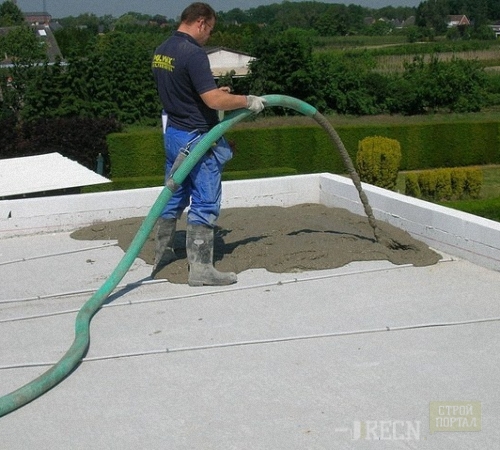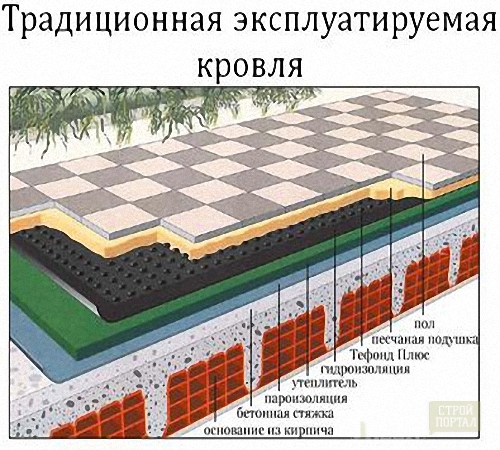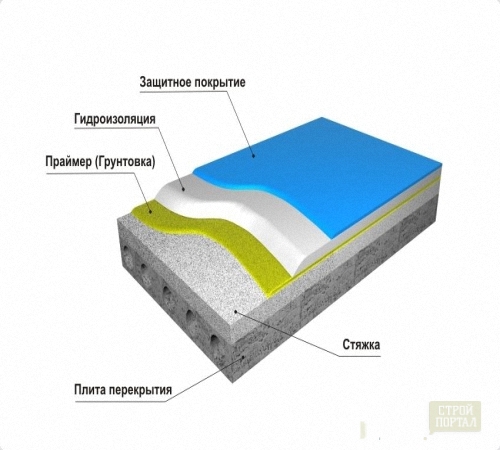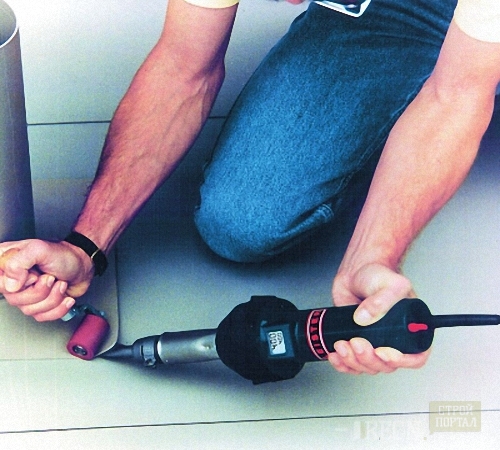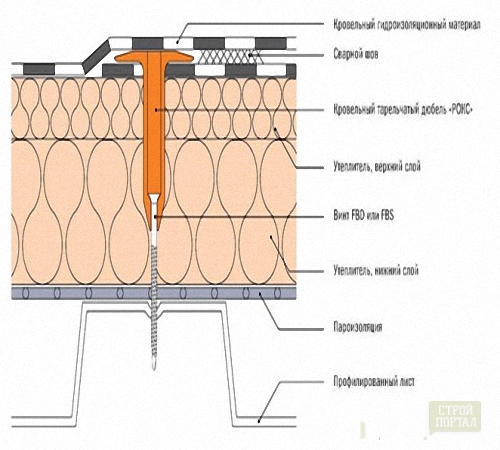
Instructions for installation of flat roofs do it yourself Construction

Today, private construction is again and again enjoys a flat roof. It is profitable, reliably and reasonable. Nowadays, the installation of a flat roof is widespread. Such a technology increases the availability of the operational area of \u200b\u200bthe room, while possessing the minimum bias. (from 2 to 5 °), in addition, the flat roof is used not only for the construction of residential buildings, but for coating terraces, garages and a variety of economic buildings.
Content
Distinctive features of a flat roof
- high reliability
- non-hatching
- easy installation,
- waterproof,
- convenience of service.
All structural elements of a flat roof have high durability and reliability. At the same time, it should be remembered that such a roof must be as much as possible. This is done to prevent the appearance of condensate acting on the ceiling. Such condensate is formed at the contact of warm air coming out of the premises. There is a docking with a cold surface of the roof coverage. In addition, moisture will accumulate in the entire structure, which will gradually destroy the device with a flat roof.
Features and types of flat roofs
Flat roofs are divided into several types:
- Traditional, or soft. This roof is based on the bearing plate, on which thermal insulation layer is mounted on top of the steam insulation layer (often use mineral wool). The thermal insulation material, due to the carpet of waterproofing, is protected from precipitation. The basis of this carpet is rolled bitumen materials.
- Inversion. This type of roof is a constructive improved technology of traditional roofs.
- Operated. Their reason is customary to do hard, which guarantees the integrity and preservation of waterproofing material. As can be seen from the title, the roof can be applied for household needs. Under the reason, it is advantageous to use a concrete tie. It will provide the necessary slope for water drain. The second option is a professional flooring. The insulation layer on such roofs is subject to increased static and dynamic loads, respectively, it is necessary to use material with great compressive strength.
- Non-exploitable. This type of flat roof does not require installation of waterproofing, and insulating work.
Direct output to the flat roof, for the benefit of its maintenance and repair provide construction bridges, or ladders that distribute all loads evenly over the entire surface. Installation of a flat soft roof is a cheaper option than scathing.
Major Benefits Flat Roof Mounting
- The minimum bias weightlifting reduces the total area of \u200b\u200bthe roof, and this reduces the cost of performing roofing and roofing materials. Moreover, heating costs are reduced, due to a smaller perimeter of heat transfer.
- Houses equipped with flat roofs have an additional area for operation, which can be used at its discretion: make a seating area, a small garden, a flower garden, or even a solarium.
disadvantages
- The minimum error in choosing a roofing material may result in rapid wear of materials.
- In winter, a huge amount of snow accumulates on the roof, which must be removed. Otherwise, the roof can flow or fall under the weight of wet snow.
Montaja technology
Installation of any flat roof requires a roofing "cake". Such a "pie" has high heat shielding characteristics that exclude attic overheating in hot time and allow you to maintain heat in winter. Moreover, the roofing "pie" can prevent the occurrence of condensate. As a result, the insulation is protected from moisture, and there will be no icing on the roof and icicles. It is important to correctly perform the design of a flat roof.
The design of the device of a flat roof includes the following layers:
- Since the beginning there is a bearing basis;
- The steam insulation layer is attached;
- It all closes a multi-layer insulation;
- And the top of the "cake" becomes a layer of waterproof.
Installation of a flat roof with his own hands begins with the preparation of the roof base. It is required to align, perfectly clean, with the help of polyurethane sealant fill all cracks in the roof, based on the flow rate of 180 grams per 1 perm. Switch width - 5 cm and depth 0.3 cm.
The second stage is a primer using epoxy primer. If the surface is porous, then you will need about 0.2 kg per square meter. On the non-porous surface - 0.12 kg. The primer must be interfered with a low-speed mixer until a homogeneous mass is, after which, exactly to ½ the mixture is divorced by water. The solution on the surface is applied with a painting roller, or a construction brush. Then, when all of the above completed, the base surface is treated with reinforcement. A special mastic is applied for this process (14 kilograms per 1 cubic meter). Before the start of polymerization, the construction bandage is mounted on it. And, after the polymerization is made - a new layer of mastic is followed.
Absolutely any roof requires vaporizolation. For this, polypropylene and polyethylene films are used. They are fixed with nails, folders or with glue. At the same time, it is necessary to observe 10 cm space for ventilation so that steam does not accumulate under the film, and condensate did not form. The thickness of the flat roof it allows. The thermal insulation material is obliged to firmly attached to the roof surface, as well as all pipes and ventilation blocks.
Waterproofing
Waterproofing of a flat roof is often performed using polymer-bitumen or membrane materials, which in the installation process are melted with among themselves gas burners.
Bituminous materials do not differ in durability, and serve only 3-4 years, after which the roof is re-coating.
Currently, the most often used membrane synthetic materials that have undeniable advantages:
- fire safety,
- high strength,
- resistance to solar rays, mechanical and natural impacts.
The data of the membranes are mounted to the roofing screed by gluing, and freely located on the basis of the load in the form of a ballast. Otherwise, the membranes are mounted in a complex method (mechanical, with the help of glue).
Mechanical fasteners occurs with rolling the surface of the material on the flooring, as a result of which it glues among himself. This is the installation throughout the roof area.
A small slope of a flat roof leads to a cluster of rainwater. To avoid this, it is necessary to make a drainage that will include internal and external channels.
With the arrangement of the internal drainage, the roof surface is divided into zones in such a way that one riser takes water from 150-200 square meters, according to the technological calculation of a flat roof. At the points of the roof point are funnels. Also, the roof is supplied with special garbage baskets.
Most often, such funnels are installed in the center of the roof, and the drainage pipes are placed inside the house. To prevent the freezing of water around the funnel, cable heating is laid.




